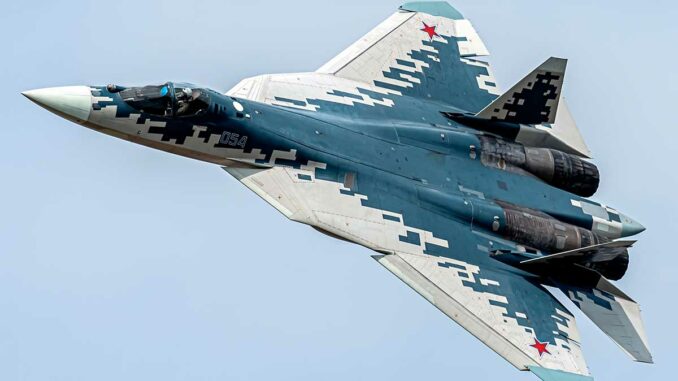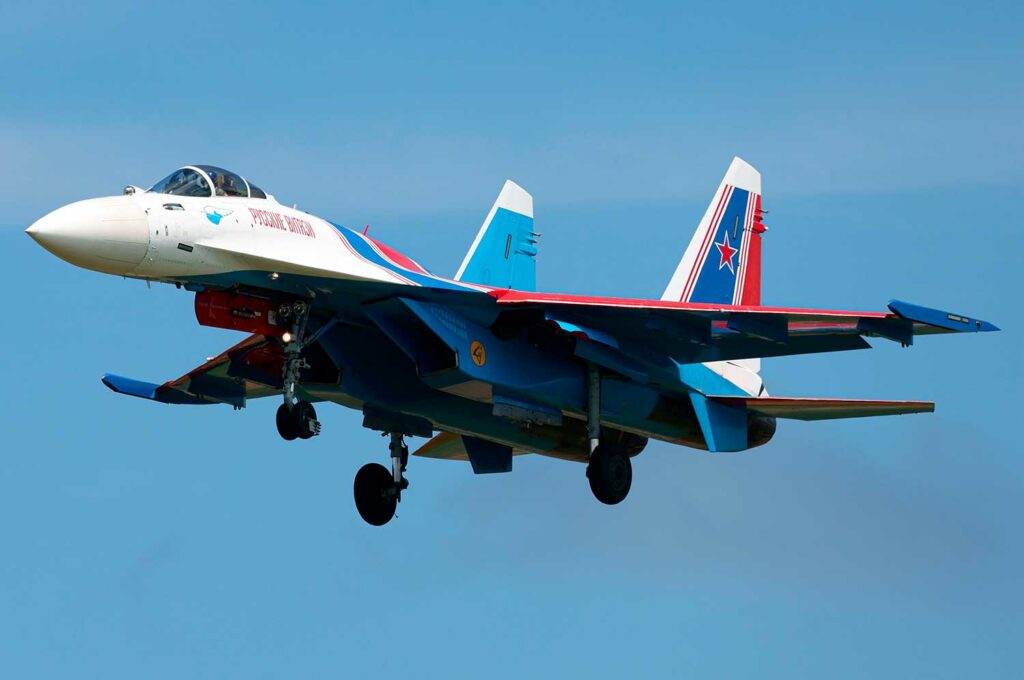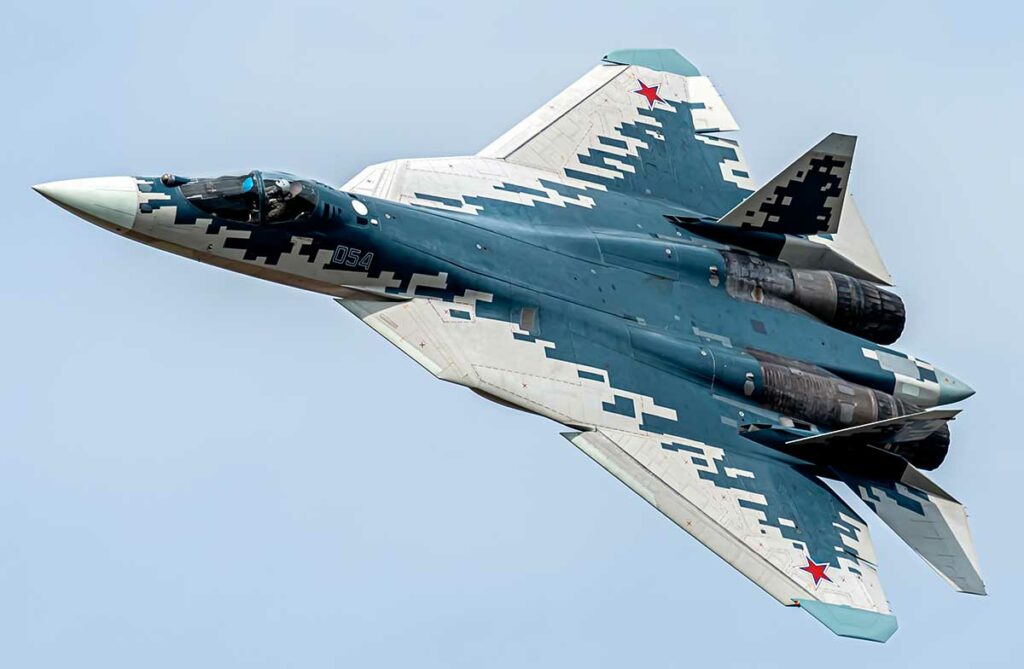
Russia is offering India the Su-57E and Su-35M with technology transfer, in a tense strategic and industrial context.
Russia is attempting to return to the Indian combat aviation market with a double offer: the Su-57E, a fifth-generation stealth fighter, and the Su-35M, a more proven air superiority platform. Moscow is banking on advanced technology transfer, local co-production via HAL, and high compatibility with the existing fleet of Su-30MKIs. This proposal comes as India seeks to quickly fill the gap in its air squadrons and support the development of its future AMCA aircraft. However, many obstacles remain: technical reliability, international sanctions, logistical constraints, and political reluctance toward a partner weakened by the war in Ukraine. The lower cost of the Su-35M and the promise of rapid delivery could appeal to New Delhi, despite the lingering shadow of the Rafale and the F-35.

A double Russian proposal against a backdrop of Indian capability shortfalls
On July 5, 2025, Rostec and Sukhoi officially submitted a combined offer to India comprising the Su-57E and Su-35M, as part of the MRFA program for 117 multirole fighter jets. This initiative responds to an immediate need for the Indian Air Force (IAF), whose fleet has fallen to 31 active squadrons, compared to 42 authorized. This operational deficit compromises its ability to maintain a strategic balance with China and Pakistan.
The proposal provides for 20 to 30 Su-57Es to be delivered between 2028 and 2029, followed by 70 to 100 additional aircraft spread out until 2033. At the same time, Moscow is offering up to 40 Su-35Ms for delivery as early as 2027. The Su-35M is presented as an immediately available solution with proven combat capabilities and a common logistics community with the Su-30MKI already in service. Rostec claims that 70 to 80% of the parts are identical, which would reduce maintenance costs and facilitate pilot adaptation.
The stakes are not limited to a one-off purchase. The Russian offer includes local production of the Su-57E at the HAL plant in Nashik, where more than 220 Su-30MKIs have already been assembled. In support of this, Moscow is offering access to software source codes and an industrial localization rate of 40 to 60%, compatible with the Make in India and Aatmanirbhar Bharat programs.
The Su-57E, a technological promise with conditions
The Su-57E is the export version of the Russian Su-57, a fifth-generation fighter aircraft equipped with AESA radar, internal missile bays, a stealth composite structure, and an integrated electronic warfare system. The aircraft is powered by the Saturn AL-41F1S engine, generating 142 kilonewtons of thrust, with three-dimensional thrust vectoring. It can reach Mach 2 and has an estimated range of 3,500 kilometers without refueling.
India could integrate its own weapons, including Astra long-range missiles (110 km), Rudram anti-radar missiles, and the locally developed Virupaksha AESA radar. The aircraft would also serve as a test bed for systems for the AMCA, India’s future sixth-generation fighter.
However, several critical limitations exist. The Su-57E has not yet been deployed on a large scale in the Russian forces. Its radar signature, although reduced, does not match that of the F-35. The aircraft has not yet proven its ability to survive modern multi-domain engagements, and its industrial chain remains dependent on Western sanctions.
Finally, the Izdeliye 177S engine, unveiled at the 2024 Zhuhai Air Show with improved thrust and a service life of 6,000 hours, has still not flown in operational conditions. Moscow is suggesting that India could finance its completion, but this industrial gamble carries high financial and technological risks.
The Su-35M as an interim solution and strategic lever
The Su-35M is based on a more conventional but robust architecture. Classified as a 4.5 generation aircraft, it is equipped with the AL-41F1S engine, the Irbis-E radar with a detection range of 400 km, and modernized avionics. It can carry up to 8 tons of payload, including R-77 and K-77M missiles (range of 200 km) and hypersonic R-37M missiles, capable of targeting AWACS aircraft at ranges of over 300 km.
The estimated unit cost is between $60 million and $75 million (between €56 million and €70 million), compared to around €110 million for a Rafale F4 with full support. The American F-35A also remains more expensive, at around €95 million according to the contract. This difference could convince the Indian Ministry of Finance, which is closely monitoring budget commitments.
The Su-35M was recently showcased during Operation Sindoor in May 2025, during which Su-30MKIs struck Pakistani air bases with BrahMos missiles. The rapid integration of the Su-35Ms into existing squadrons, taking advantage of the logistics base already in place for the Su-30MKIs (nearly 920 AL-31FP engines assembled since 2004), is a strong tactical argument for New Delhi.
Persistent reservations about the strategic and industrial rationale
Despite the operational interest, serious doubts remain within the Indian military leadership. The Su-30MKI program has suffered from significant maintenance problems, exacerbated by Western sanctions against Russia since 2014. A 2018 report (Jane’s Defense Weekly) estimated that up to 40% of the Indian fleet was sometimes grounded due to a lack of spare parts.
The CAATSA sanctions imposed by the United States against Russia’s military partners pose a legal and economic risk. Their application could jeopardize India’s access to other Western technologies (missiles, components, maintenance), including for systems already in service.
The Su-35M, although inexpensive, could also slow down the development of the AMCA by diverting human and budgetary resources. As for the Su-57E, it imposes prolonged technological dependence on Russia at a time when India is seeking to secure its industrial chains through more balanced partnerships, notably with France, Israel, and the United States.
Finally, there is the question of operational credibility. Neither the Su-57E nor the Su-35M have faced opponents with technological air superiority. Their evaluation is based on Russian internal simulations and tests, which are not very transparent.

A strategic decision under intense political pressure
India finds itself having to choose between the need for rapid reinforcement, strategic independence, budgetary sustainability, and international reputation. Western partnerships offer better integration into C4ISR networks, NATO interoperability, and a more stable political relationship.
But the Russian proposal is based on industrial pragmatism: accelerated deliveries, compatibility with the existing fleet, and real transfers. If Western offers are blocked (due to delays, prices, or restrictions), Moscow offers a credible short-term alternative, even if its structural limitations hinder full acceptance.
India’s strategy could be to split the deal: partial acquisition of Su-35Ms to make up for the immediate shortfall, targeted co-development of certain technological components of the Su-57E to feed into the AMCA program, while staying on track with the Rafale F4 or other strategic partners for long-term solutions.
War Wings Daily is an independant magazine.